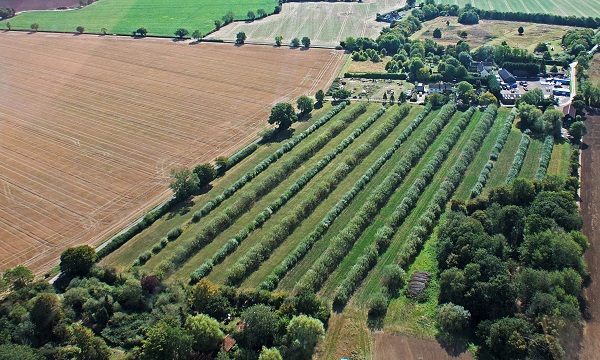
Many farms will be able to maintain their productivity and meet the sustainable farming scheme requirement by planting trees and hedges to provide shade and shelter and protect against soil erosion and pollution.
Coed Cadw, the Woodland Trust in Wales, is considering its response to the Welsh Government’s proposal of a 10% minimum tree cover requirement for those farms who apply for public funding through the new Sustainable Farming Scheme.
On average, tree cover on farms in Wales is already at 6-7%, so for many farms making this up to 10% is a relatively modest requirement. Coed Cadw suggests that many farms will be able to achieve this in ways which support the farm business as well as providing wider public benefits that justify public funding, for example, by planting and restoring trees, hedges and woods to provide shade and shelter and protect against soil erosion and pollution.
“We support the policy to significantly increase tree cover on farms,” said Coed Cadw’s Wales Director, Natalie Buttriss. “We think that it is necessary and desirable, both for farming and the public. This is clearly a big change for farmers and we think it is appropriate to use public funding through the Sustainable Farming Scheme to support farmers in making this change.”
Coed Cadw notes that: –
- Farms are NOT required to plant 10% of their land, only to bring their existing tree and woodland cover up to 10%.
- On average farms in Wales already have 6-7% tree cover.
- The costs of new planting will be fully met by Welsh Government grants, and, for the first time, farms in the Scheme will receive a payment for the area of tree and woodland cover that they maintain.
- Farms are NOT required to take 20% of their land out of production as tree cover and habitat. There is lots of flexibility here, including counting native tree and woodland cover towards both the tree cover and habitat requirement. Habitat includes species rich grassland and heathland which continues to be grazed and productive and where farms do not have enough of these permanent habitats, they can meet the requirement by creating temporary habitat of value, such as multi-species pastures.
As farmers and commentators express concerns around the proposed Scheme requirements, Coed Cadw has reiterated the need to support the family farming sector and their belief in the farming and public benefits of increasing tree cover on farms. In their ‘10 Asks of the Sustainable Farming Scheme they have set what they think is required and take steps towards achieving 10% tree cover.
Farmers are on the front line of the climate and nature crisis, and trees on farms are vital for pollinators, livestock welfare, flood mitigation and carbon capture and storage. Native trees can naturally filter and screen pollution reducing soil, and carbon loss and pollution of streams and rivers.
Coed Cadw encourages and supports farmers to consider how to incorporate trees into their farming practices to aid productivity and sustainability, as many have traditionally done. It has shared a number of case studies where farmers have put trees to use on their farm in the form of ‘hedges and edges’, or agroforestry system. This approach has also been widely supported from across all Senedd political parties.
Farming is facing many financial and sustainability challenges and Coed Cadw supports a balanced approach which addresses the financial viability of family farms with environmental protection, climate threats and wildlife decline. A focus is needed on tangible but achievable changes.
Natalie Buttriss explains,
“We need a multi-faceted approach to tackling these wider challenges. We firmly believe that the basic minimum tree cover and habitat requirements in this scheme will help farming, the environment and the population of Wales. We know from working directly with farmers across Wales that many are finding successful ways of working with trees that are good for their farm business, the natural environment, as well as the public, whilst complementing quality, sustainable food production. With flexibility and innovation this is all achievable.
There are a range of options that we think are worth exploring further and this current consultation is an opportunity to do this. We will be making further suggestions of changes that might help.
We are committed to fostering a positive dialogue when it comes to trees on farms, and to working collaboratively towards achieving the sustainable future outlined by the 10% tree cover target,” Natalie added.
The Vital Role of Trees on farms
During last year’s summer drought, we saw the highest temperature on record in Wales (37.1C in Hawarden, Flintshire). Right across Wales, farmers were looking at brown, arid pastures; many had to dig into their winter reserves to be able to feed their livestock. Already cash-poor, they took a significant financial hit in having to buy in additional expensive livestock feeds – this has been repeated for some with the late spring and early summer drought of 2023, compounding the water scarcity that had occurred in 2022.
The act of incorporating more trees on farms – by way of planting what Coed Cadw calls ‘hedges and edges’ – offers multiple benefits in tackling escalating impacts of the climate and nature crisis in years to come.
In tackling heat, drought and floods
Flooding, heat waves and droughts are likely to become more and more commonplace as climate change bites.
As heavy rainfall pours off the mountainsides, hastened by artificial farm and forest drainage, a lack of the right tree cover, in the right places means there are few barriers to naturally slow it down
In the coming years, increasing native tree and hedgerow cover across upland slopes, alongside ravines, streams, and gullies will be key to mitigating the escalating impacts, and the financial and human costs of flooding.
Trees and hedges will also be essential to provide shade and shelter to protect against heat and drought, whilst improving soil carbon, organic matter and soil fertility, reducing soil moisture loss. Increasing tree cover helps rain to go deeper into the soil, whilst also bringing water and nutrients up from depth.
Preventing erosion, pollution and improving river health
Developing native woodland along river corridors will be vital to reverse the loss of freshwater wildlife, and the land-based wildlife that depend on rivers. Freshwater biodiversity is extremely sensitive to heat extremes (as evidenced by our once-thriving Salmon population which is now in extreme decline). Trees along rivers can also screen and cool freshwater and reduce soil erosion, whilst intercepting pollutants and farm run-off too.
Improving outcomes for livestock
Increasing appropriate tree cover as part of the farm system is a natural benefit to livestock wellbeing. Trees provide additional shade to heat stressed, and heat sensitive livestock, and provides another natural source of livestock feed, known as tree fodder or tree hay.
Livestock can be happier, healthier and more productive grazing and foraging amongst trees and sheltered by hedges, whilst crops can grow in-between tree rows, assisted naturally by the trees providing partial shade, and bringing up nutrients, and helping water to be held deeper and for longer within soils.











